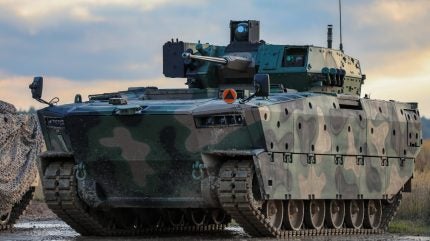
The Armaments Agency on behalf of the State Treasury of the Republic of Poland and a consortium comprising Polska Grupa Zbrojeniowa and Huta Stalowa Wola, have signed the first executive agreement for the supply of Borsuk infantry fighting vehicles (IFVs).
The Polish Armed Forces are set to receive 111 Borsuk IFVs as part of the deal, valued at approximately 6.57bn zlotys ($1.69bn) gross.
The agreement also covers comprehensive training and logistics packages.
Additionally, it provides for the development of technical documentation for serial production, the creation of a commission acceptance test programme, and the execution of these tests.
Deliveries of these tracked IFVs, which are designed to transport troops safely on the battlefield, are scheduled between 2025 and 2029.
The latest development is said to be a direct outcome of a framework agreement concluded on 28 February 2023.
This framework set the terms for executive agreements related to the Borsuk IFV and other specialist vehicles.
The Borsuk IFV project was initiated in 2014 with Huta Stalowa Wola leading the development.
Deputy Minister Paweł Bejda said: “It happened. We will produce Borsuk in Poland. One hundred percent of Polish technological thought. We are fulfilling what we went to the elections with, with Prime Minister Władysław Kosiniak – Kamysz, saying that at least 50% of spending on armaments should stay in Polish armaments plants. Today we are fulfilling our promise.”
“This is a very great day for soldiers who will use this very modern and safe equipment with the most modern unmanned turret in the world. Borsuk also means technical support vehicles, medical vehicles, command vehicles, chemical reconnaissance vehicles – this is a whole set of vehicles that will serve in the Polish Army.”
Over time, approximately 1,400 vehicles, including the ŻUK, OSET, GOTEM, GEKON, and ARES models, will be acquired to form a comprehensive fleet of military assets.
The Borsuk IFV is a response to both current and future requirements of the armed forces, aiming to replace the outdated Soviet-era BWP-1s.
To meet these needs promptly, there will be a focus on increasing the production capacity of the contractor.
The vehicle is built on a universal modular tracked platform and features a ZSSW-30 remote-controlled turret system equipped with a 30mm cannon, a 7.62mm machine gun, and an anti-tank guided missile launcher.
It can carry a crew of three and transport six soldiers to combat zones while providing necessary protection and firepower support to infantry units.
In addition, the Ministry of National Defence has developed the concept of the Polish Defence Fund (PDF), led by the advisor to the Minister of National Defence, Maciej Samsonowicz.
The PDF will invest in defence and dual-use technologies, supporting the modernisation of Poland’s military capabilities and enhancing the security of Poland, Nato’s eastern flank, and Europe.


